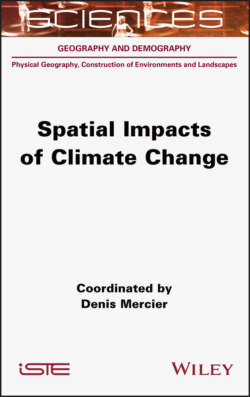Читать книгу Spatial Impacts of Climate Change - Denis Mercier - Страница 25
2.2. The sensitivity of the cryosphere to climate change
ОглавлениеThe cryosphere is defined as the cold sphere (from the Greek kruos, the cold), and occurs on Earth in various forms from water to solid ice. These include the two ice sheets in Greenland and Antarctica, icecap glaciers such as Vatnajokull in Iceland, valley and cirque glaciers in mountains at almost all latitudes, permafrost, snow, lake and river ice, and sea ice and icebergs (see Figure 2.1). The cryosphere is thus seasonal (snow) or multi-millennia (ice sheets, permafrost).
According to sources, the cryosphere on Earth occupies more than 36 million km2, or 24% of the continents. Depending on the season, the marine cryosphere covers between 19 and 28 million km2, or 5.3 to 7.8% of the ocean surface. The continental cryosphere mainly represents 30.2 million km3 of freshwater, which represents a potential theoretical sea level rise of 74 m (65 m for Antarctica, 7 m for Greenland, 1.1 m for permafrost, 24 cm for mountain glaciers, and less than 1 cm for snow; see Table 2.1 and Francou and Vincent 2011). However, since much of the cryosphere is a multi-millennia legacy, some of its components are not subject to contemporary climate change. For example, the Antarctic continent has been frozen for millions of years, since plate tectonics placed it in a polar orbital position, and a huge part of its 27 million km3 of ice is fortunately unaffected by contemporary warming. However, the sensitivity of the Greenland ice sheet is greater because of its smaller size and its position in the heart of the Arctic, which is particularly affected by current warming (see Chapter 1).
Table 2.1. The components of the cryosphere. The marine cryosphere is not included in this table because the melting of the sea ice does not induce sea level rise
(source: Francou and Vincent 2011)
| Cryosphere component | Surface area in km2 | Volume in km3 (water equivalent) | Sea level equivalent (the surface of the oceans represents 361 million km2) |
| Antarctica | 12.4 million | 27 million | 65 m |
| Greenland | 1.8 million | 2.7 million | 7 m |
| Permafrost | 23 million | 0.24 million | 1.1 m |
| Mountain glaciers | 0.43 million | 0.08 million | 0.24 m |
| Snow | 4 to 46 million | 500 to 5000 | 0.1 to 1 cm |
Figure 2.1. Extension of the cryosphere. For a color version of this figure, see www.iste.co.uk/mercier/climate.zip
(source: © Hugo Ahlenius, UNEP/GRID-Arendal)
The cryosphere is highly sensitive to climate change for two physical reasons. The first is the increase in surface air and seawater temperatures, which induces a transition from solid to liquid state. The second reason is correlated with the increase in air temperatures, which induces a decrease in solid (snowy) precipitation, which contributes to a reduction of the mass balance of glaciers of all sizes.
Moreover, the cryosphere is sensitive to the fundamental role played by albedo. The bright surfaces of the marine and terrestrial cryosphere reflect a significant proportion of solar radiation (see Chapter 1). Snow reflects 75-95% of the sun's energy, glaciers 40-60%. The reduction of these areas with a high albedo potential automatically leads to an increase in areas that absorb more solar radiation and, through a positive feedback loop, contribute to the warming of the lower layers of the atmosphere.
